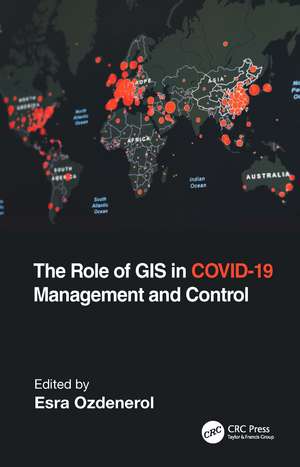The Role of GIS in COVID-19 Management and Control
Editat de Esra Ozdenerolen Limba Engleză Hardback – 4 mai 2023
Features:
- Provides cutting-edge GIS visualization, spatial temporal pattern, and hot spot tracking applications used for predictive modeling of COVID-19.
- Includes real-world case studies with broad geographic scope that reflect COVID-19 trends in cases, deaths, and vaccinations.
- Provides lifestyle segmentation analysis on the risk of transmission of COVID-19 and spatial patterns of vaccination hesitancy.
- Highlights real-world issues brought to light with the help of GIS, such as social discrimination, inequalities in women’s access to mental health care, and analyzes the risk of transmission due to vaccination hesitancy.
- Shows the use of GIS and spatial analysis in pandemic mapping, management, and control from masking and social distancing to testing site locations accounting for at-risk and vulnerable populations.
- Discusses facilitating policy making with GIS.
| Toate formatele și edițiile | Preț | Express |
|---|---|---|
| Paperback (1) | 357.44 lei 3-5 săpt. | +25.62 lei 4-10 zile |
| Taylor & Francis Ltd. – 19 dec 2024 | 357.44 lei 3-5 săpt. | +25.62 lei 4-10 zile |
| Hardback (1) | 657.83 lei 6-8 săpt. | |
| CRC Press – 4 mai 2023 | 657.83 lei 6-8 săpt. |
Preț: 657.83 lei
Preț vechi: 954.96 lei
-31% Nou
Puncte Express: 987
Preț estimativ în valută:
125.89€ • 130.05$ • 104.77£
125.89€ • 130.05$ • 104.77£
Carte tipărită la comandă
Livrare economică 25 martie-08 aprilie
Preluare comenzi: 021 569.72.76
Specificații
ISBN-13: 9781032129754
ISBN-10: 1032129751
Pagini: 310
Ilustrații: 31 Tables, black and white; 1 Line drawings, color; 11 Line drawings, black and white; 29 Halftones, color; 64 Halftones, black and white; 29 Illustrations, color; 75 Illustrations, black and white
Dimensiuni: 156 x 234 x 23 mm
Greutate: 0.73 kg
Ediția:1
Editura: CRC Press
Colecția CRC Press
ISBN-10: 1032129751
Pagini: 310
Ilustrații: 31 Tables, black and white; 1 Line drawings, color; 11 Line drawings, black and white; 29 Halftones, color; 64 Halftones, black and white; 29 Illustrations, color; 75 Illustrations, black and white
Dimensiuni: 156 x 234 x 23 mm
Greutate: 0.73 kg
Ediția:1
Editura: CRC Press
Colecția CRC Press
Public țintă
Postgraduate, Professional, and Undergraduate AdvancedCuprins
1. The Role of GIS in COVID-19 Management and Control 2. Information Access as a Strategy to Overcome Health Inequities in the Context of COVID-19 3. Spatial Pattern of COVID-19 Positivity Rates in Indonesia during Local Restriction Phase: A Case study of Jakarta and Surabaya City 4. Investigating Spatial Relationships of Age and Comorbidities on COVID-19 Spread Using Geographically Weighted Regression 5. Spatiotemporal Patterns of Covid-19: A District-level Analysis of Kerala, India, 2020-2021 6. The 2020 Hurricanes, Internal Displacements and COVID-19 in Latin America and the Caribbean Countries: Lessons Learned for Disaster Risk Reduction 7. Hot Spot Tracker: Detecting and Visualizing the Types of Spatiotemporal Hot Spots of COVID-19 in the United States 8. Lifestyle Effects on the Risk of Transmission of COVID-19 in the United States: Evaluation of Market Segmentation Systems 9. A Bibliometric Review of Research on the Role of GIS in COVID19 Pandemic Control and Management: Science Mapping the Literature, 2020 – 2022 10. The Use of Geographic Information Systems to Shape COVID Policies Regarding Masking and Distancing with A Partially Vaccinated Population 11. Using GIS to Map Women’s Health, Well-being and Economic Opportunities in the Context of COVID-19 12. The Effects of Lifestyle on COVID-19 Vaccine Hesitancy in the United States: An Analysis of Market Segmentation 13. A Gendered Approach to Examining Pandemic Induced Livelihood Crisis in the Informal Sector: the Case of Female Domestic Workers in Titwala
Notă biografică
Dr. Esra Ozdenerol is a professor in the Department of Earth Sciences at the University of Memphis and has been since 2003. She is also affiliated with the Departments of Preventive Medicine and Health Outcome Policy of the University of Tennessee Health Science Center. She is the director of the GIS Certificate Program at the University of Memphis, and she directs the Spatial Analysis and Geographic Education Laboratory in the Department of Earth Sciences. Dr. Ozdenerol was the associate director of Benjamin L. Hooks Institute for Social Change at the University of Memphis from 2010 to 2013. She earned her doctorate degree in Geography in 2000 and her Master of Landscape Architecture degree in 1996 from the Louisiana State University. She earned her Bachelor of Science degree in Landscape Architecture and Agricultural Engineering from the University of Ankara, Turkey. Before joining the University of Memphis, she was an assistant professor of architecture at Florida International University in Miami from 2000 to 2003. Dr. Ozdenerol specializes in geographic information systems and has served as a technical consultant to various public, governmental, and international agencies. Her latest publications are on studies about spatial health inequalities. She has published two books with Taylor & Francis - Spatial Health Inequalities: Adapting GIS Tools and Data Analysis (2016) and Gender Inequalities: GIS approaches to Gender Analysis (2021).
Descriere
Edited by medical geographer and GIS Professor Dr. Esra Ozdenerol, this book highlights key GIS capabilities and lessons learned during the COVID-19 response and can help communities prepare for the next crisis. 12 global projects are discussed with a multidisciplinary approach, illustrating the role of GIS in crisis management.
